24 Jan 2022 - {{hitsCtrl.values.hits}}
Reminiscences of Air Chief Marshal Deshamanya P. H. Mendis on the occasion of 50 years since assuming command of the SLAF
I had the honour and privilege to have an audience with Air Chief Marshal (ACM) Mendis popularly known as Paddy Mendis, the living legend of the Air Force at his private residence in Mt Lavinia on August 19, 2020. It was a very fascinating experience to listen to him go back the memory lane
“It was flying that attracted me while studying at S. Thomas’ College Mount Lavinia in the 1950s. I used to ‘cut’ school with my friend Rakitha Wickramanayake and go to Ratmalana Airport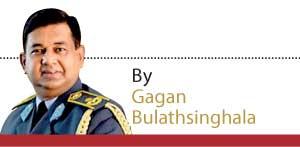 to get free rides in aeroplanes from other students.
to get free rides in aeroplanes from other students.
“My friend Rakitha went for civil flying but, I could not afford it. Meanwhile, the Air Force advertised for pilots and I applied. I was born in the middle in a family of five and my father was a doctor from Hikkaduwa and my mother was a housewife. There was strong objection from my parents to go for the interview because they did not want me to fly and get killed, but eventually, they permitted and I got selected. That is how I realised my dream,” he recollected the memorable movement that started his Air Force career.
Air Chief Marshal Deshamanya Pathman Hariprasadha Mendis IDC, PSC, FBIM, QFI, was born in 1933 and was the fourth Commander of the Royal Ceylon Air Force from 1971 to 1976. “I had the honour and privilege to have an audience with Air Chief Marshal (ACM) Mendis popularly known as Paddy Mendis, the living legend of the Air Force at his private residence in Mt Lavinia on August 19, 2020. It was a very fascinating experience to listen to him go back the memory lane. I was quite surprised at his ability to unfold events that happened over seven decades ago so clearly and sequentially. Also, it was a challenge for me to keep abreast with him, and whenever I digressed from the course he brought me back on track very gently.
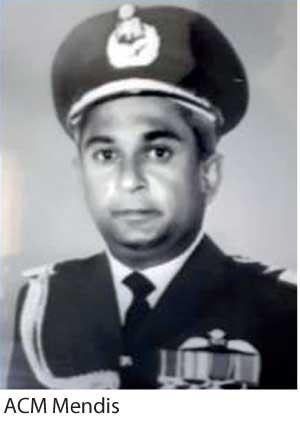 The extracts of the discourse are penned out as a tribute to ACM Mendis’s Golden Jubilee Anniversary of taking over command of the Royal Ceylon Air Force on January 1, 1971 and also to keep the younger generation apprised of how the Sri Lanka Air Force has come of age from its early formative days.
The extracts of the discourse are penned out as a tribute to ACM Mendis’s Golden Jubilee Anniversary of taking over command of the Royal Ceylon Air Force on January 1, 1971 and also to keep the younger generation apprised of how the Sri Lanka Air Force has come of age from its early formative days.
In 1950 once the Air Force Act was legislated, the British Government seconded a Royal Air Force (RAF) officer, Gp Capt G. C. Bladon as the Air Advisor in May 1950, at the request of the Government of Ceylon. His assignment was to formulate the establishment of an Air Force for Ceylon at that time.
ACM Mendis joined the newly formed Royal Ceylon Air Force (RCyAF) as its fifth recruit, 1005 AC2 (Cadet) on August 8, 1951. After being enlisted to the RCyAF, Cadet Officer Mendis and Cadet Officer D. De S. Seneviratne were selected and sent to Britain for their training at Royal Air Force (RAF) College Cranwell UK. RAF College Cranwell has a long and distinguished history dating back to its foundations as a Royal Navy Training Establishment in 1916. It was the world’s first Air Academy and even as of today, it continues to select and train the next generation of officers and aircrew.
"On completion of his flying instructor training at Royal Air Force Central Flying School, ACM Mendis become a flying instructor at the Royal Ceylon Air Force Flying School Katunayake"
“The education system there was of a very high standard, which went up to the university level. The training was in three wings, flying, military and academic studies. Initially, I found it very difficult, so I had to work very hard. I even studied in the toilet after the ‘lights out’ at ten O’clock. Everyone knew what I was doing in the toilet for about one hour every night but, they
|
Chipmunk aircraft |
ignored it realising my predicament and determination” he said.
|
Air Force Academy at SLAF China Bay for officer training |
At the RAF College Cranwell, young entrants are initially known as Cadets and after six months of training, they became Flight Cadets. Just three months prior to being graduated as a Pilot Officer they are designated as Senior Flight Cadets. Young Cadet Mendis did his basic flying training in the Chipmunk aircraft and flew one hundred and ten hours followed by flying the Harvard aircraft for another one hundred and ten hours. After being commissioned on April 6, 1954, young Pilot Officer Mendis continued training on the De Havilland Vampire for his operational conversion for seventy hours at RAF Merryfield.
The Vampire is a British jet combat fighter that was developed and manufactured by the De Havilland Aircraft Company. It was the second jet fighter to be operated by the Royal Air Force (RAF). The Vampire was developed as an experimental aircraft in 1941 during the Second World War to exploit the ground-breaking innovation of jet propulsion. The Vampire entered operational service in 1946 with the RAF only months after the war had ended. Pilot Officers Mendis and Seneviratne returned to Ceylon in December 1954.
At that time the Government of Ceylon under the Commonwealth has had a concept of having a squadron of 12 Vampire aircraft to be based in Ceylon as part of the Commonwealth Defence Strategy for the region.
"ACM Mendis’s name is listed in the Alumni of the Royal College of Defence Studies and as a graduate has entitled himself for the post-nominal letters IDC"
As planned the Vampires arrived in Ceylon in early 1954. However, this concept did not materialise due to the financial constraints that prevailed. The concept of operation then changed to a transport aircraft role instead of the offensive capability that was initially planned. A decision had been taken to re-ship the Vampires back to the third county in South East Asia.
With this change of approach, the government at that time had decided to deploy more transport aircraft instead of the Vampires. By this time Flying Officer Mendis was converted and trained on to the Airspeed Oxford, a twin-engine aircraft developed and manufactured by Airspeed. It saw widespread use for training British Commonwealth aircrews in navigation, radio-operating, bombing and gunnery roles throughout the Second World War.
|
ACM Mendis at Cranwell College |
Further, in the meantime, the Royal Ceylon Air Force (RCyAF) had established a squadron with Chipmunks, Balliol, Oxfords, Doves and Herons at Katunayake. The flying wing operated with segregation on training and operational framework.
Also in 1954, twelve Boulton Paul Balliol Aircraft, a three-seat advanced trainer powered by a turboprop engine. The pilot and instructor sat side by side ahead of the observer. These aircraft were acquired and put into service the same year and were used for the training of the No 1 Flying cadets course at Katunayake.
In 1955, Prestwick Pioneer aircraft (4 nos.) were also purchased and used in the transport role. Further, as the ACM recollects the operational flight consisted of a mix of aircraft from Doves, Oxfords Pioneers, Herons.
The first helicopter to enter the RCyAF inventory was the Westland Sikorsky S 51 Dragonfly in 1956 which was used by the Royal Navy on the Search and Rescue role. The first two RCyAF pilots to be trained on helicopters were S. M. V. Situnayake and M. A. De Soysa.
Though ACM could not be specific of their rank at the time of the conversion training both of them retired later as Squadron Leaders. Their helicopter training in Ceylon was done by Commander Sproule of the Royal Navy.
"Wing Commander Mendis performed extremely well in all his duties and progressed steadily in his career. The hierarchy of RCyAF at that time decided to promote Wing Commander Mendis to the next rank of Group Captain and groom him further to take up higher responsibility"
In the interim Fight Lieutenants, Mendis and Situnayake were sent to the UK in 1959 to the RAF Central Flying School (CFS) to be trained as flying instructors in RAF Little Rissington in
|
The Vampire jet combat fighter |
|
ACM Mendis after his retirement |
Gloucestershire. The CFS is the Royal Air Force’s primary institution for the training of military flying instructors. CFS was established in 1912, it is the longest existing flying training school. Its motto is “Imprimis Praecepta” which is Latin for “Our Teaching is Everlasting”. CFS currently manages a series of training squadrons as well as the RAF display aerobatic Team “Red Arrows” who are presently based in RAF Waddington.
On completion of his flying instructor training at Royal Air Force Central Flying School, ACM Mendis become a flying instructor at the Royal Ceylon Air Force Flying School Katunayake. In 1961 the flying wing that was established was split as No 1 Squadron and No. 2 Squadron, and Squadron Leader Mendis took over command of the newly formed No. 2 (Transport) Squadron.
Further, Squadron Leader Mendis was selected to follow his staff training at Defense Services Staff College, Wellington, India, in 1961/62. On completion of the Staff college training, he was promoted to the rank of Wing Commander and was appointed as the Senior Air Staff Officer at Air Force Headquarters in 1963.
Wing Commander Mendis performed extremely well in all his duties and progressed steadily in his career. The hierarchy of RCyAF at that time decided to promote Wing Commander Mendis to the next rank of Group Captain and groom him further to take up higher responsibility. In furtherance of this objective Group Captain Mendis was selected and sent to the Imperial Defence College which is now known as the Royal College of Defence Studies (RCDS) in the UK. At this point, ACM Mendis elaborated that his career advancement was aligned on the principle of “Opportunity and Reward”.
"ACM Mendis established the Air Force Academy at SLAF China Bay for officer training. Also, the Electronic Maintenance and Training school at SLAF Ekala, Trade training School at SLAF Katunayake for ground crew training were also established"
|
Westland Sikorsky S 51 Dragonfly |
The RCDS as it is renamed now, prepares senior officers and officials of the United Kingdom and other countries (predominantly Commonwealth), future leaders from the private and public sectors for high responsibilities in their respective organisations by developing their analytical powers, knowledge of Defence and international security and strategic vision. ACM Mendis’s name is listed in the Alumni of the Royal College of Defence Studies and as a graduate has entitled himself for the post-nominal letters IDC.
On his return to Ceylon after the successful completion of Imperial Defence College, he was appointed as the Chief of staff in December 1969 and continued to perform duties in the appointment. Being the Chief of Staff, from October 1970 Group Captain Mendis was entrusted with more responsibilities and continued to perform duties of the Commander under the guidance of AVM E.R. Amarasekara.
ACM Mendis was appointed as the fourth Commander of the Air Force in January 1971. The biggest challenge of ACMs lifetime was accepting and assuming command of the Royal Ceylon Air Force with approximately 3,000 personnel at the young age of thirty-eight. It was a further challenge for him when a full-blown insurrection occurred three months after he took over command.
When ACM Mendis took over command his office was located at the Rifle Green House and his official residence was at Interlaken in Parson’s Road (presently known as Sir Chittampalam A. Gardiner Mawatha). After a few months in the occupation, the Government offered an official Residence to the commander at No 14, Stanmore Crescent in Colombo 7. ACM Mendis was the first commander to occupy the “Air House” which remains as the official residence of the Commander of the Air Force.
Three months later, the RCyAF was mobilised for combat for the first time when the 1971 Janatha Vimukthi Peramuna (JVP) insurrection commenced. Though unprepared for a full-scale
|
ACM Mendis was appointed as the fourth Commander of the Air Force on January 1971 |
insurrection, with a limited number of aircraft under ACM Mendis’ command, the Air Force responded effectively.
At first, RCyAF had to carry reinforcements and supplies to stations under threat. That kept all the police stations under threat fully replenished preventing them from being falling prey to the subverts. In addition to the air supply for the sustenance of police stations, RCyAF was tasked to provide air to ground surgical strikes on selected targets.
Due to the heavy flying commitment of the helicopters, the RCyAF had to grapple with the serious issue of not having enough spare parts to keep the helicopters sustained. In consultation with the government which resulted in quick diplomatic initiatives, friendly foreign countries rallied around to support the government to crush the subversion.
"ACM Mendis was appointed as the fourth Commander of the Air Force in January 1971. The biggest challenge of ACMs lifetime was accepting and assuming command of the Royal Ceylon Air Force with approximately 3,000 personnel at the young age of thirty-eight. It was a further challenge for him when a full-blown insurrection occurred three months after he took over command"
The first to respond was the United States of America. As a result, a swift induction of Jet Ranger helicopters along with Bell 47G helicopters and stock of spares were received from the US within hours of the request being made. The US initiative was matched immediately by the USSR at that time by the supply of MIG 15 and MIG 17 aircraft along with a heap of the military aviation-related arsenal. The diplomatic initiatives of the superpowers were also matched by the regional neighbours. Due to the spontaneous activation of the friendly foreign countries, the RCyAF was blessed with an abundance of resources such as aircraft, aviation-related equipment in addition to being
|
Rifle Green House |
offered troops to secure our airfields so that our troops could be used on counter-insurgency offensive operations. As a result of the combined efforts, the insurrection was brought under control in two months. The RCyAF rose to the occasion and did perform extremely well.
However, following the insurrection, military spending was drastically reduced as a result of major economic difficulties faced by the country. Further, the Air Force by that time had grown in size with more aircraft, pilots and a volunteer force. Also, with Ceylon becoming a Republic in 1972, the Royal Ceylon Air Force changed its name to the Sri Lanka Air Force (SLAF) along with all insignia. Due to the country’s economic status financial constraints had to be imposed and ACM Mendis was forced to look at alternate options to keep the Air Force sustained. Air Force pursued a national policy of regaining through state ventures with limited foreign aid.
ACM Mendis explained that he was never discouraged in the presence of a shortage of funds or resources and somehow found the
|
De Havilland Heron aircraft |
way out and completed his tasks in a praiseworthy manner. His innovative thinking resulted in the creation of “Helitours” in 1972, which was the brainchild of ACM Mendis. It was to cater to the tourist industry, which was a novel concept with Air Force planes and pilots to finance the operation of the Air Force. Helitours became a popular mode of transportation for the growing tourism industry and by the end of 1972, Helitours spread its wings further to the Maldives as well. In 1973 a used Convair 440, a twin-engined aircraft that could carry 44-52 passengers used by several airlines was inducted to boost Helitours’ operations between Ceylon and the Maldives. Further, the Government of Maldives in consultation with the Government of Sri Lanka appointed ACM Mendis as their air adviser due to his extraordinary aviation expertise. That led to him being instrumental in the forming of the Air Maldives on October 1, 1974, as the national airline and flag carrier of the Maldives. By that time Helitours turned out to be an effective module to share the burden of the cash crunch.
"ACM Mendis though retired from active service remains engaged in the spirit of a serviceman and who never misses any SLAF event that he is invited to whatever it may be"
With the transformation from RCyAF to the SLAF ACM Mendis, saw the need to rethink the operational structure for much better efficiency. The current management structure was
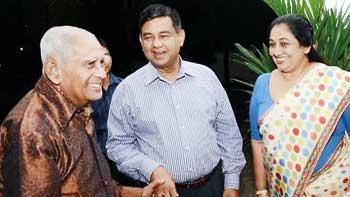 |
|
Family of ACM Mendis |
introduced that had more than the RAF three-pronged system of flying, engineering and administration. More specialisation was added headed by a director who was the head of the branch in the rank of Group Captain or Wing Commander and established the Board of Management as the policy-making apex body of the SLAF which remains intact.
Some other noteworthy milestones that were achieved were the technical modification of De Havilland Heron aircraft as the Riley Heron. The need to enhance the endurance, speed and comfort of the De Havilland Heron aircraft was felt at that time. The Gypsy Queen mark 30 engines were replaced with Avco Lycoming IO-540 locally. The modification gave an advantage in weight as well as fuel efficiency and converted the Heron aircraft into much-needed efficiency, comfort and luxury.
In keeping with the national policy of revitalisation of the agriculture sector and striving for self-sufficiency and agriculture growth, the Morawewa Agro unit was established on July 29, 1973.
In Addition, ACM Mendis established the Air Force Academy at SLAF China Bay for officer training. Also, the Electronic Maintenance and Training school at SLAF Ekala, Trade training School at SLAF Katunayake for ground crew training were also established. Further, the engine and propeller overhaul bay was established at Katunayake, by which a considerable amount of foreign exchange was saved for the country. He is also credited with introducing the decentralized independent formation system within the Air Force. Air Chief Marshal P. H. Mendis retired from the Sri Lanka Air Force in 1976 in the rank of Air Vice-Marshal.
ACM Mendis though retired from active service remains engaged in the spirit of a serviceman and who never misses any SLAF event that he is invited to whatever it may be.
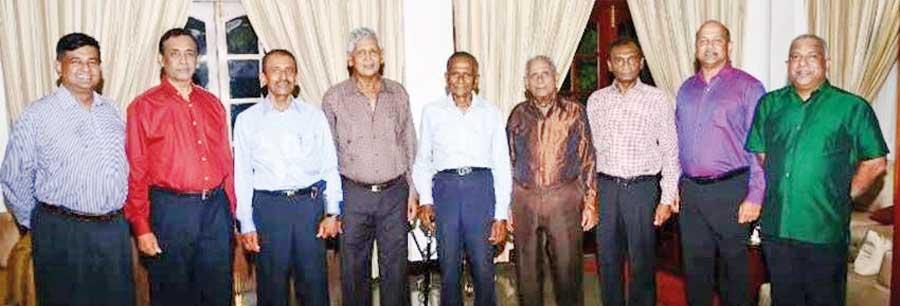
ACM Mendis visiting the Air House in 2015
Though he had hung his blue uniforms, due to his amazing competencies and invaluable experience under no circumstances did the nation allow him to retire. Subsequently, after retiring
|
“Helitours” created in 1972 |
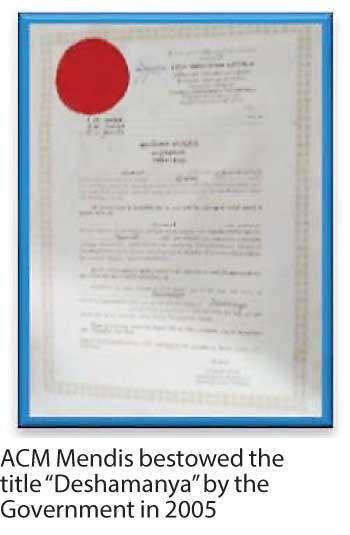 he continued to work in the government sector as Chairman, Air Ceylon; Commissioner General, Civil Defence and Aviation; member, Reserve Affairs Council. Finally, he retired in 2007 at the age of 75 as Chairman of Civil Aviation Authority after a working life of 58 years.
he continued to work in the government sector as Chairman, Air Ceylon; Commissioner General, Civil Defence and Aviation; member, Reserve Affairs Council. Finally, he retired in 2007 at the age of 75 as Chairman of Civil Aviation Authority after a working life of 58 years.
In recognition of the great services rendered to Defence and Aviation, he was bestowed the title “Deshamanya” by the Government in 2005. Further, he was promoted to the rank of Air Chief Marshal on October 1, 2007.
Air Chief Marshal P. H. Mendis as an ace military aviator has some golden advice to the younger generation which is of paramount importance in today’s context;
“I never considered the Air Force to be a job or a source of employment. It is a way of life. You join the Air Force and become part of the service and remain a part of it always. If you look at it purely as a job and when am I getting the next holiday or when am I going somewhere or it is now five o’clock, it is time to go home - If that is your attitude I don’t think you will go very far. I enjoyed my work all the time and I never consider it a job. It was a way of life. Don’t do anything just for money.”
“Air Force has been exceptionally good to me. There is no doubt that what I am, what I was and what I will be is all due to the Air Force. It took me as an eighteen-year-old and trained me. Right up to date I am still with the Air Force in one way or another”, he said very proudly.
He married Charmaine in 1957, and they were blessed with three children, five grandchildren and two great-grandchildren. One of his grandsons who followed his grandfather’s footsteps
|
Helitours became a popular mode of transportation for the growing tourism industry |
was a midshipman at the US Naval Academy Annapolis, who graduated with the Class of 2010. 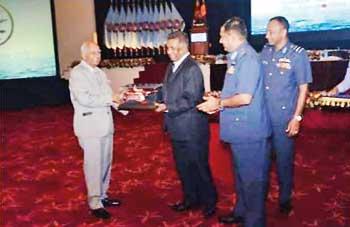
In addition to Air Chief Marshal Deshamanya P. H. Mendis, I wish to give credit and acknowledge the Sri Lanka Air Force website for the information and picture courtesy and also to Ms Ramani Kanganaarachi and Rohan Abeywardena for the extracts of their interviews with the ACM published.
We salute this legendary officer and a Gentleman, the ace aviator, for what the nation and the Sri Lanka Air Force has achieved today, and we wish him longevity!
The writer is Air Chief Marshal Gagan Bulathsinghala RWP, RSP, VSV, USP, MPhil, MSc, FIM(SL), ndc, psc and Former Commander of the Sri Lanka Air Force and Sri Lankan Ambassador to Afghanistan.
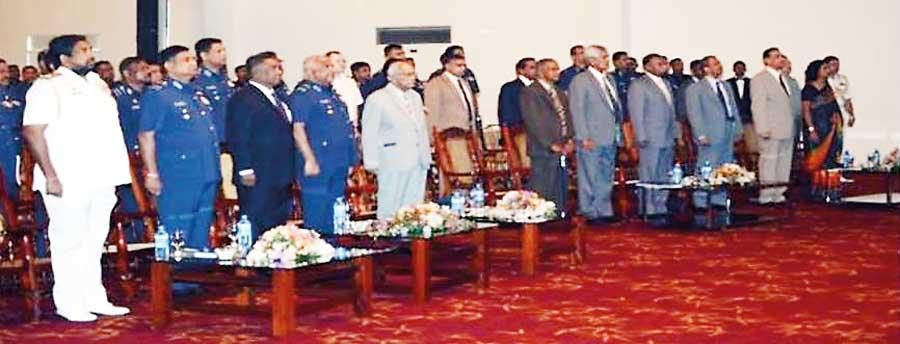
At the inaugural Air Power Symposium 2015
24 Nov 2024 16 minute ago
24 Nov 2024 58 minute ago
23 Nov 2024 23 Nov 2024
23 Nov 2024 23 Nov 2024
23 Nov 2024 23 Nov 2024